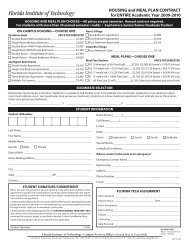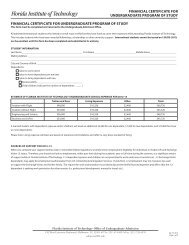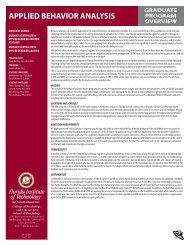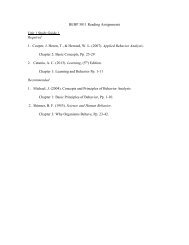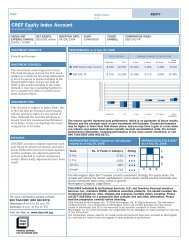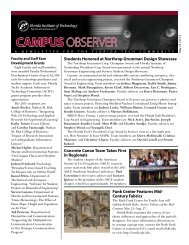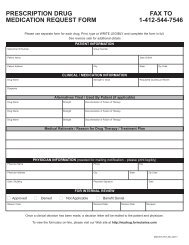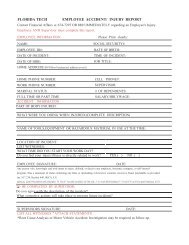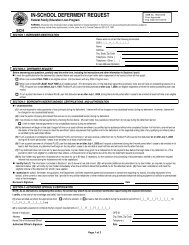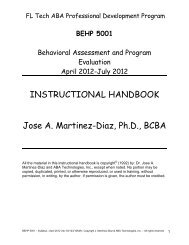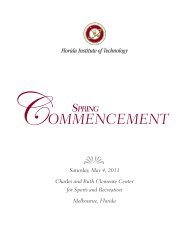2008–2009 - Florida Institute of Technology
2008–2009 - Florida Institute of Technology
2008–2009 - Florida Institute of Technology
Create successful ePaper yourself
Turn your PDF publications into a flip-book with our unique Google optimized e-Paper software.
Associate Pr<strong>of</strong>essors<br />
David C. Fleming, Ph.D., structural mechanics, advanced composite<br />
materials, crashworthy aerospace vehicle design, finite element analysis,<br />
fracture mechanics.<br />
Hector Gutierrez, Ph.D., P.E., mechatronics, nonlinear control,<br />
microprocessor control <strong>of</strong> electromechanical systems, magnetic suspension<br />
systems, intelligent control, automation, computer-based instrumentation,<br />
computer-aided engineering <strong>of</strong> control systems.<br />
Kunal Mitra, Ph.D., thermal fluid sciences with emphasis on laser<br />
applications, thermal radiation, microscale heat transfer, material<br />
processing, bio-heat transfer modeling, biomedical imaging, short-pulse<br />
laser therapy, photovoltaic systems.<br />
Paavo Sepri, Ph.D., fluid mechanics, turbulence, convective heat transfer,<br />
boundary layers, aerodynamics, wind tunnel testing, droplet combustion,<br />
computational fluid dynamics.<br />
Yahya I. Sharaf-Eldeen, Ph.D., P.E., modeling, simulation, and design<br />
<strong>of</strong> dynamic systems, advanced dynamics, vibration, design <strong>of</strong> machinery,<br />
thermal-fluid sciences, energy/power systems.<br />
Assistant Pr<strong>of</strong>essors<br />
Mark R. Archambault, Ph.D., rocket combustion and propulsion, rocket<br />
fuel injector modeling, computational fluid dynamics, multi-phase fluid<br />
flow, spray and particulate dynamics, hydrogen fuel cell modeling.<br />
Youngsik Choi, Ph.D., superfinish hard machining service life methodology,<br />
micro-electrodischarge machining (MEDM)system, machine designs.<br />
Daniel R. Kirk, Ph.D., fluid mechanics, heat transfer, combustion, airbreathing<br />
propulsion, chemical and nuclear thermal rocket propulsion,<br />
shock tube flow experimentation, high-speed aerodynamics, internal flows,<br />
superconductivity for launch assist, spacecraft shielding, energy storage and<br />
propulsion.<br />
Razvan Rusovici, Ph.D., structural dynamics, smart material applications,<br />
damping modeling, vibration and acoustics, sensors and instrumentation,<br />
experimental modal analysis, turbomachinery.<br />
Bo Yang, Ph.D., micro-/nano-mechanics, fabrication and reliability <strong>of</strong><br />
advanced materials and devices, fracture mechanics, mesh-reduction<br />
computational methods, boundary elements, molecular dynamics,<br />
multiscale modeling.<br />
Shengyuan Yang, Ph.D., cell and tissue mechanics and mechanobiology,<br />
micro-electro/mechanical systems (MEMS), nano-electro/mechanical<br />
systems (NEMS), bio-MEMS/NEMS.<br />
Adjunct Faculty<br />
J. Martin, Ph.D.; T. Mashburn, Ph.D.; D. Tse, Ph.D.; B. Vu, Ph.D.;<br />
D. Willard, M.S.<br />
Pr<strong>of</strong>essors Emeriti<br />
Thomas E. Bowman, Ph.D.; Armand Dilpare, Ph.D.;<br />
John J. Engblom, Ph.D., P.E.; John M. Russell, Sc.D.;<br />
Palmer C. Stiles, M.S.<br />
Mission Statement<br />
The mission <strong>of</strong> the mechanical and aerospace engineering department<br />
is to prepare our students to be successful pr<strong>of</strong>essionals<br />
in the global industrial, research and/or academic environment.<br />
This is achieved via developing curricula that enable students<br />
to achieve four education objectives: academic fundamentals,<br />
engineering practices, teamwork and communication, and pr<strong>of</strong>essional<br />
development. Graduates <strong>of</strong> the mechanical and aerospace<br />
engineering department are equipped with the knowledge and<br />
capabilities to solve real-world engineering problems and to<br />
advance the state-<strong>of</strong>-the-art in their selected fields.<br />
unDergrADuATe Degree ProgrAmS<br />
Undergraduate Programs Chair<br />
Chelakara S. Subramanian, Ph.D.<br />
Bachelor <strong>of</strong> Science<br />
Aerospace Engineering _______________________<br />
The field <strong>of</strong> aerospace engineering has grown rapidly in recent<br />
decades to assume a vital role in modern human endeavors.<br />
Ranging from manned lunar excursions, exploration <strong>of</strong> the solar<br />
system and ecological study <strong>of</strong> Earth, to beneficial commerce on<br />
space stations and high-quality products for humans and military<br />
concerns, the contributions from the aerospace engineering<br />
pr<strong>of</strong>ession have been pr<strong>of</strong>ound. Accomplishments in airframe<br />
materials, computational fluid dynamics and propulsion system<br />
designs have resulted in the circumnavigation <strong>of</strong> Earth by an<br />
airplane without recourse to refueling. Aerospace engineers are<br />
currently involved in space station operations and are expected to<br />
take part in future moon-base and space station missions, as well<br />
as manned exploration <strong>of</strong> Mars. The many spin-<strong>of</strong>fs from their<br />
involvement in these activities in space will surely benefit humanity<br />
here on Earth just as their previous space involvement has.<br />
The aerospace engineering undergraduate curriculum at <strong>Florida</strong><br />
Tech presents the fundamentals underlying modern aerospace<br />
engineering and prepares the student for a lifetime <strong>of</strong> continued<br />
learning. During the freshman and sophomore years, emphasis is<br />
placed on mathematics and physics, while aerospace engineering<br />
is introduced through a sequence <strong>of</strong> three courses. The sophomore<br />
and junior years direct the student toward the engineering<br />
sciences, including materials science, thermodynamics and<br />
fluid mechanics. During the junior and senior years, the study<br />
becomes progressively centered on the specific issues facing<br />
practicing aerospace engineers. The student uses the basic tools<br />
imparted during the first two years and applies them in studies<br />
<strong>of</strong> aerodynamics, propulsion systems, aerospace structures and<br />
design projects. Other courses taken during the last two years<br />
expand the student’s knowledge in the fields <strong>of</strong> mechanics <strong>of</strong><br />
solids, electric circuits, flight stability and control, and mission<br />
analysis. Technical electives taken during the junior and senior<br />
years allow the student to direct the program toward specific<br />
areas <strong>of</strong> personal interest, such as flight training and human factors<br />
engineering, space science, mathematics, computer science<br />
or other engineering disciplines.<br />
Laboratory experiences are essential to the education <strong>of</strong> engineers,<br />
and these are provided in chemistry, physics, computers,<br />
materials, fluids, structures and experimental aerodynamics. The<br />
capstone <strong>of</strong> the educational process is embodied in the aerospace<br />
engineering design project, which synthesizes and focuses<br />
elements from the various disciplines into a design activity <strong>of</strong><br />
current aerospace engineering interest. The faculty <strong>of</strong> the program<br />
serve jointly in the supervision and consultation for these<br />
projects.<br />
Students are encouraged to define career objectives early in<br />
the program (preferably during the sophomore year), so that in<br />
consultation with faculty advisers, electives can be selected that<br />
are best suited to the achievement <strong>of</strong> specific goals.<br />
Students may also choose to benefit from the experience gained<br />
through the cooperative education program.<br />
Degree Programs—College <strong>of</strong> Engineering 91



